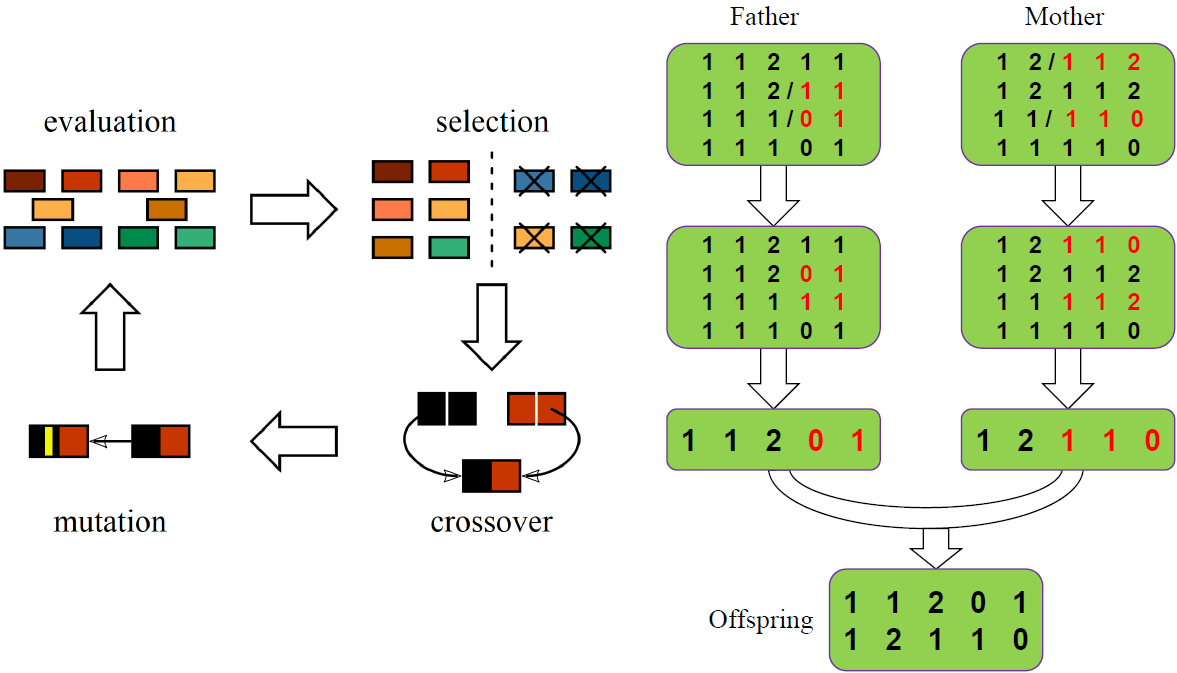-
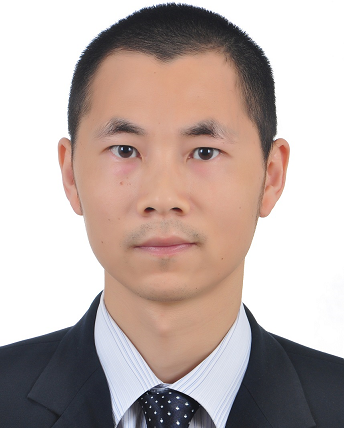
姓 名:胡少军
职 称:副教授
办公室:#317
电 话:029-87091641
邮 箱:hsj AT nwsuaf DOT edu DOT cn
基本信息 胡少军,男,1980年3月生,湖北省松滋市人,工学博士,副教授,硕士研究生导师。
学习经历
1999年9月-2003年7月,西北农林科技大学,计算机科学与技术系,学士,指导教师:何东健教授;
2003年9月-2006年7月,西北农林科技大学机电学院,硕士,指导教师:何东健教授、耿楠教授;
2006年10月-2009年9月,日本岩手大学电子信息专业,博士,指导教师:千叶则茂教授、藤本忠博教授。
工作经历
2009年10月-2010年6月,日本岩手大学计算机图形学研究室,学术研究员,指导教师:千叶则茂教授;
2010年11月-2014年6月,西北农林科技大学,讲师;
2014年10月-2015年2月,维也纳科技大学,计算机图形学与算法研究所,博士后,指导教师:Michael Wimmer博士;
2016年3月-2017年3月,东京大学,计算机科学系,用户界面研究室,访问学者,指导教师:Takeo Igarashi教授;
2013年7月至今,西北农林科技大学,学术型硕士生导师;
2014年7月至今,西北农林科技大学,副教授。
学术兼职
陕西省图象图形学会理事;担任《IEEE TVCG》、《The Visual Computer》、《Computers and Electronics in Agriculture》、《Computer Animation & Virtual Worlds》等期刊审稿人。
获奖情况
2007年获日本文部科学省(MONBUKAGAKUSHO)博士生奖学金;
2014年获欧亚-太平洋大学联盟(EURASIA-PACIFIC UNINET)博士后奖学金。
研究方向 计算机图形学、计算机动画、植物建模与动画 开设课程 承担本科生课程:
[3] 面向对象程序设计(课程负责人) [课件] [代码] [参考资源] [IDE]
[5] 虚拟现实技术(课程负责人) [课件] [代码] [参考资源] [IDE]
[7] 数据结构与C语言综合实训 [选题资料] [参考资源]
承担研究生课程:
[2] 高级计算机三维建模(课程负责人) [课件] [大作业] [参考资源]
参编教材:数字图像处理(第三版, 十二五). 西安电子科技大学出版社. 2015年2月. ISBN: 9787560635972. [Link]
学术成果 主持基金项目
[1] 国家自然科学基金项目青年项目(61303124),复杂条件下真实感树动画模拟方法研究,26万,2013.1-2015.12;
[2] 教育部留学回国人员科研启动基金(K308021401),基于视频的真实感树动模拟方法研究,3.5万,2014.1-2015.12;
[3] 陕西省自然科学基金(2015JQ6250),基于数据驱动和物理模型的树动画模拟方法,2万,2015.1-2016.12;
[4] 国家高技术研究发展计划(863计划)课题子任务(2013AA10230402),作物三维点云重构方法研究,35 万,2013.1-2017.12;
[5] 中央高校基本科研业务费重点项目(Z109021708),基于CT影像的盆栽植物三维重建方法,15万,2017.1-2019.12。
代表作
[1] Shaojun Hu*, Zhengrong Li, Zhiyi Zhang, Dongjian He, Michael Wimmer. Efficient tree modeling from airborne LiDAR point clouds. Computer & Graphics. 67: 1-13, 2017. doi: 10.1016/j.cag.2017.04.004. (SCI, JCR Q3) [Link][Preprint][Video][Binary][Appendix]
[2] Shaojun Hu*, Zhiyi Zhang, Haoran Xie, Takeo Igarashi. Data-driven modeling and animation of outdoor trees through interactive approach. The Visual Computer. 33(6-8): 1017-1027, 2017. doi:10.1007/s00371-017-1377-6. (Accepted by CGI2017, acceptance rate = 20%) (SCI, JCR Q2) [Link][Preprint][Video][Binary][Appendix] [Slides]
[3] 何鹏, 胡少军, 何东健. 基于Kinect的树运动轨迹获取与振动频率分析. 系统仿真学报. 29(7): 1412-1418, 2017. [Link] [Preprint]
[4] 师翊, 何鹏, 胡少军, 张志毅, 张晶, 耿楠, 何东健. 基于角度约束空间殖民算法的树点云几何结构重建方法. 农业机械学报. 2017. (EI源刊) [Link][Preprint]
[5] Shaojun Hu, Peng He, Dongjian He. Motion capture and estimation of dynamic properties for realistic tree animation. EU AniNex Workshop, Bournemouth, U.K., 2017. (EI源刊) [Link][Preprint][Video][Binary]
[6] 何东健,邵小宁,王丹,胡少军. Kinect获取植物三维点云数据的去噪方法. 农业机械学报. 47(1):331-336, 2016. doi: 10.6041/j.issn.1000-1298.2016.01.045. (EI) [Link][Preprint]
[7] Nan Geng, Shaojun Hu, Zhiyi Zhang. Modeling rippled fractal patterns of leaves. Journal of Computational Information Systems. 11(5): 1837-1845, 2015. (EI) [Preprint]
[8] 胡少军,耿楠,张志毅,杨沛,何东健. 基于稀疏图像的真实树交互式建模方法. 农业工程学报. 30(9):168-175, 2014. doi: 10.3969/j.issn.1002-6819.2014.09.021. (EI) [Link][Preprint]
[9] Xiaoqian Jiang*, Shaojun Hu*, Qi Xu, Yujun Chang, Shiheng Tao. Relative effects of segregation and recombination on the evolution of sex in finite diploid populations. Heredity. 111: 505-512, 2013. doi:10.1038/hdy.2013.72. (*These authors contributed equally to this work) (SCI, JCR Q1) [Link][Binary]
[10] Chunquan Liang, Yang Zhang, Shanjun Hu. Learning decision tree from time-changing uncertain data streams. Information Technology Journal. 12(24): 8469-8475, 2013. (EI) [Link][Preprint]
[11] Shaojun Hu*, Norishige Chiba, Dongjian He. Realistic animation of interactive trees. The Visual Computer. 28(6-8): 859-868, 2012. doi: 10.1007/s00371-012-0694-z. (Accepted by CGI2012, acceptance rate = 18%) (SCI, JCR Q2) [Link][Preprint][Video1][Video2][Binary][Slides]
[12] Shaojun Hu*, Tadahiro Fujimoto, Norishige Chiba. Pseudo-dynamics model of a cantilever beam for animating flexible leaves and branches in wind field. Computer Animation and Virtual Worlds. 20(2-3): 279-287, 2009. doi: 10.1002/cav.309. (Accepted by CASA2009, acceptance rate = 33%) (SCI) [Link][Preprint][Video1][Video2][Video3][Binary][Slides]
[13] Shaojun Hu, Tadahiro Fujimoto, Norishige Chiba. Visual simulation of broad leaves deforming in wind field. NICOGRAPH International, CD ROM, Pattaya, Thailand, 2008. (Full paper with conference talk) [Link][Preprint][Video1][Video2][Slides]
[14] 胡少军, 何东健, 汪有科, 林艳梅, 马理辉. OpenGL与Creator/Vega结合的渠系仿真系统优化设计. 系统仿真学报. 19(5):1157-1160, 2007. (EI) [Link][Preprint]
[15] 胡少军, 何东健, 耿楠, 郭亚红. 基于图像处理的小麦叶片形态的三维重建. 农业工程学报. 23(1):150-154, 2007. (EI) [Link][Preprint]
已授权发明专利
胡少军, 何东健等. 一种基于稀疏图像的真实树交互式建模方法. ZL2014100913289. 发明专利. 2017年6月 [Link]
胡少军, 何东健等. 一种基于简化模态分析法的树动画模拟方法. ZL2014100913274. 发明专利. 2017年8月 [Link]
博士论文
Shaojun Hu. A study on a hybrid method for modeling and animating leaves and branches. Ph.D. dissertation, Iwate University, Japan, September 2009. [Preprint][Slides]
在读学生 硕士二年级:黄正宇,于世瑾,朱超,罗广宇,魏拓
硕士一年级:张馨月,李琰琛,王浩毕业学生 2016届:何鹏(协助指导) [去哪儿网], 付浩文[深圳市茁壮网络股份], 张高原[海南航空], 卫琦 [山西省运城市选调生]
-
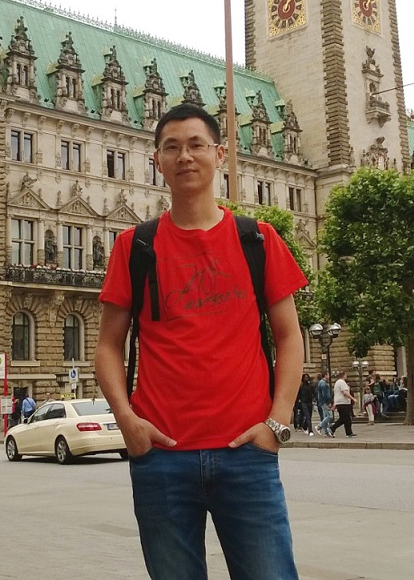
Name:Shaojun HU
Title:Assoc. Professor
Office:Room 317
Tel:+86-29-87092700
Email:hsj AT nwsuaf DOT edu DOT cn
Personal Information I received my Ph.D. degree from the Graduate School of Information Science and Technology at Iwate University, Japan in September 2009 and my supervisors were Prof. Norishige Chiba and Prof. Tadahiro Fujimoto. I worked with Prof. Michael Wimmer from October 2014 to February 2015 at the Institute of Computer Graphics and Algorithms, Vienna University of Technology. I also worked with Prof. Takeo Igarashi at the User Interface Research Group, the University of Tokyo as a visiting researcher for one year from March 2016 to March 2017. I joined the Department of Computer Science at Northwest A&F University in 2010 as a Lecturer, and became an Associate Professor in 2014. Research Directions Computer graphics, computer animation, natural phenomena Selected Publications Efficient tree modeling from airborne LiDAR point clouds
Shaojun Hua, Zhengrong Lib, Zhiyi Zhanga, Dongjian Hec, Michael Wimmerd
a. College of Information Engineering, Northwest A&F University, China
b. Beijing New3S Technology Co.Ltd., China
c. College of Mechanical and Electronic Engineering, Northwest A&F University, China
d. Institute of Computer Graphics and Algorithms, Vienna University of Technology, Austria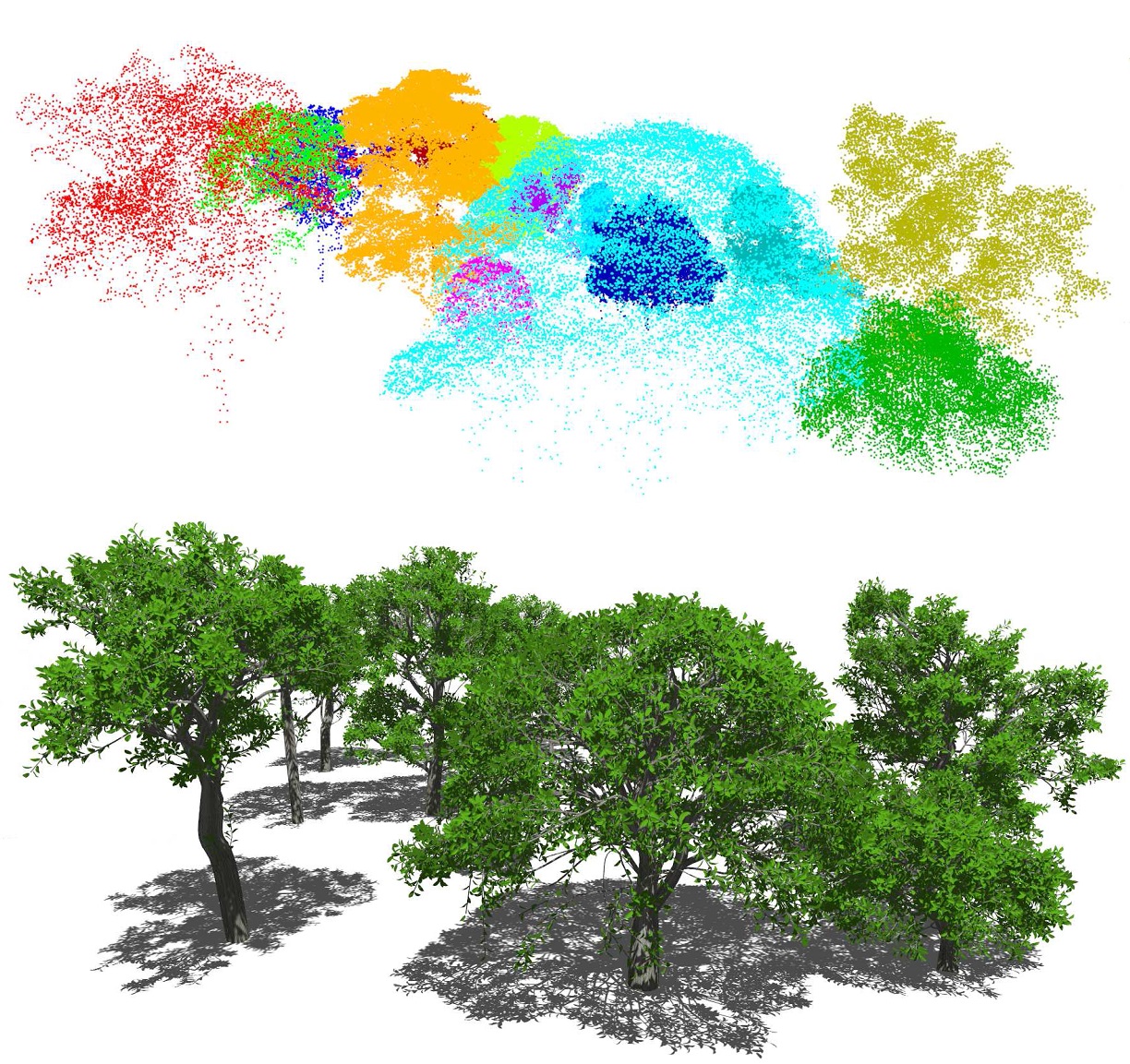
Abstract
Modeling real-world trees is important in many application areas, including computer graphics, botany and forestry. An example of a modeling method is reconstruction from light detection and ranging (LiDAR) scans. In contrast to terrestrial LiDAR systems, airborne LiDAR systems – even current high-resolution systems – capture only very few samples on tree branches, which makes the reconstruction of trees from airborne LiDAR a challenging task. In this paper, we present a new method to model plausible trees with fine details from airborne LiDAR point clouds. To reconstruct tree models, first, we use a normalized cut method to segment an individual tree point cloud. Then, trunk points are added to supplement the incomplete point cloud, and a connected graph is constructed by searching sufficient nearest neighbors for each point. Based on the observation of real-world trees, a direction field is created to restrict branch directions. Then, branch skeletons are constructed using a bottom-up greedy algorithm with a priority queue, and leaves are arranged according to phyllotaxis. We demonstrate our method on a variety of examples and show that it can generate a plausible tree model in less than one second, in addition to preserving features of the original point cloud.
Shaojun Hu, Zhengrong Li, Zhiyi Zhang, Dongjian He, Michael Wimmer. Efficient tree modeling from airborne LiDAR point clouds. Computer & Graphics, 2017. doi: 10.1016/j.cag.2017.04.004. [Link][Preprint][Video][Binary][Appendix]
Acknowledgments
We would like to kindly thank Prof. Takeo Igarashi and the anonymous reviewers. This work was supported by the National 863 Plan [2013AA10230402], NSFC[61303124], NSBR Plan of Shaanxi [2015JQ6250], and Eurasia-Pacific Uninet Post-Doc Scholarship from OEAD.
BibTeX
@article{Hu_LZHW2017,
author = " Hu, Shaojun and Li, Zhengrong and Zhang, Zhiyi and He, Dongjian and Wimmer, Michael",
title = "Efficient tree modeling from airborne LiDAR point clouds ",
journal = "Computers /& Graphics ",
volume = "67",
pages = "1 - 13",
year = "2017",
doi = "10.1016/j.cag.2017.04.004"
}Data-driven modeling and animation of outdoor trees through interactive approach
Shaojun Hua, Zhiyi Zhanga, Haoran Xieb, Takeo Igarashib
a. College of Information Engineering, Northwest A&F University, China
b. Graduate School of Information Science and Technology, The University of Tokyo, Japan
Abstract
Computer animation of trees has widespread applications in the fields of film production, video games and virtual reality. Physics-based methods are feasible solutions to achieve good approximations of tree movements. However, realistically animating a specific tree in the real world remains a challenge since physics-based methods rely on dynamic properties that are difficult to measure. In this paper, we present a low-cost interactive approach to model and animate outdoor trees from photographs and videos, which can be captured using a smartphone or handheld camera. An interactive editing approach is proposed to reconstruct detailed branches from photographs by considering an epipolar constraint. To track the motions of branches and leaves, a semi-automatic tracking method is presented to allow the user to interactively correct mis-tracked features. Then, the physical parameters of branches and leaves are estimated using a fast Fourier transform, and these properties are applied to a simplified physics-based model to generate animations of trees with various external forces. We compare the animation results with reference videos on several examples and demonstrate that our approach can achieve realistic tree animation.
Shaojun Hu, Zhiyi Zhang, Haoran Xie, Takeo Igarashi. Data-driven modeling and animation of outdoor trees through interactive approach. The Visual Computer, 2017. doi:10.1007/s00371-017-1377-6. (Accepted by CGI2017) [Link][Preprint][Video][Binary][Appendix][Slides]
Acknowledgments
We thank Hironori Yoshida, Seung-tak Noh and the anonymous reviewers. This work was supported by NSFC [61303124], National 863 Plan [2013AA10230402] and NSBR Plan of Shaanxi [2015JQ6250].
BibTeX
@article{Hu_ZXI2017,
author="Hu, Shaojun and Zhang, Zhiyi and Xie, Haoran and Igarashi, Takeo",
title="Data-driven modeling and animation of outdoor trees through interactive approach",
journal="The Visual Computer",
year="2017",
volume="33",
number="6",
pages="1017--1027",
doi="10.1007/s00371-017-1377-6"
}Relative effects of segregation and recombination on the evolution of sex in finite diploid populations
Xiaoqian Jianga,b,e, Shaojun Huc,e, Qi Xud, Yujun Changa,b and Shiheng Taoa,b
a. College of Life Science, Northwest A&F University, China
b. Bioinformatics Center, Northwest A&F University, China
c. College of Information Engineering, Northwest A&F University, China
d. College of Animal Science and Technology, Yangzhou University, China
e. These authors contributed equally to this workAbstract
The mechanism of reproducing more viable offspring in response to selection is a major factor influencing the advantages of sex. In diploids, sexual reproduction combines genotype by recombination and segregation. Theoretical studies of sexual reproduction have investigated the advantage of recombination in haploids. However, the potential advantage of segregation in diploids is less studied. This study aimed to quantify the relative contribution of recombination and segregation to the evolution of sex in finite diploids by using multilocus simulations. The mean fitness of a sexually or asexually reproduced population was calculated to describe the long-term effects of sex. The evolutionary fate of a sex or recombination modifier was also monitored to investigate the short-term effects of sex. Two different scenarios of mutations were considered: (1) only deleterious mutations were present and (2) a combination of deleterious and beneficial mutations. Results showed that the combined effects of segregation and recombination strongly contributed to the evolution of sex in diploids. If deleterious mutations were only present, segregation efficiently slowed down the speed of Muller’s ratchet. As the recombination level was increased, the accumulation of deleterious mutations was totally inhibited and recombination substantially contributed to the evolution of sex. The presence of beneficial mutations evidently increased the fixation rate of a recombination modifier. We also observed that the twofold cost of sex was easily to overcome in diploids if a sex modifier caused a moderate frequency of sex.
Xiaoqian Jiang, Shaojun Hu, Qi Xu, Yujun Chang, Shiheng Tao. Relative effects of segregation and recombination on the evolution of sex in finite diploid populations. Heredity. 111: 505-512, 2013. doi:10.1038/hdy.2013.72. [Link][Binary]
Acknowledgments
Special thanks to Baolin Mu for his help in improving the speed of our computer program. We are grateful to the members at the Bioinformatics Center of Northwest A&F University for their generosity in providing their computer clusters to run our simulations. We also thank three anonymous reviewers for their constructive comments.
BibTeX
@article{Jiang2013,
author=" Jiang, Xiaoqian and Hu, Shaojun and Xu, Qi and Chang, Yujun and Tao, Shiheng",
title=" Relative effects of segregation and recombination on the evolution of sex in finite diploid populations",
journal=" Heredity",
year="2013",
volume="111",
pages="505--512",
doi="10.1038/hdy.2013.72"
}Realistic animation of interactive trees
Shaojun Hua, Norishige Chibab, Dongjian Hec
a. College of Information Engineering, Northwest A&F University, China
b. Dept. of Computer and Information Sciences, Iwate University, Japan
c. Mechanical and Electronic Engineering, Northwest A&F University, China
Abstract
We present a mathematical model for animating trees realistically by taking into account the influence of natural frequencies and damping ratios. To create realistic motion of branches, we choose three basic mode shapes from the modal analysis of a curved beam, and combine them with a driven harmonic oscillator to approximate Lissajous curve which is observed in pull-and-release test of real trees. The forced vibration of trees is animated by utilizing local coordinate transformation before applying the forced vibration model of curved beams. In addition, we assume petioles are flexible to create natural motion of leaves. A wind field is generated by three-dimensional fBm noises to interact with the trees. Besides, our animation model allows users to interactively manipulate trees. We demonstrate several examples to show the realistic motion of interactive trees without using pre-computation or GPU acceleration. Various motions of trees can be achieved by choosing different combinations of natural frequencies and damping ratios according to tree species and seasons.
Shaojun Hu, Norishige Chiba, Dongjian He. Realistic animation of interactive trees. The Visual Computer, 2012. doi: 10.1007/s00371-012-0694-z. (Accepted by CGI2012) [Link][Preprint][Video1][Video2][Binary][Slides]
Acknowledgments
The authors would like to thank anonymous reviewers for their helpful suggestions. This work was partially supported by the Doctoral Start-up Funds (2010BSJJ059), the Fundamental Research Funds (QN2011135) of Northwest A&F University, and the National Science & Technology Supporting Plan of China (2011BAD29B08).
BibTeX
@article{Hu_CH2012,
author="Hu, Shaojun and Chiba, Norishige and He, Dongjian",
title="Realistic animation of interactive trees",
journal="The Visual Computer",
year="2012",
volume="28",
number="6",
pages="859--868",
doi="10.1007/s00371-012-0694-z"
}Pseudo-dynamics model of a cantilever beam for animating flexible leaves and branches in wind field
Shaojun Hua, Tadahiro Fujimotoa, Norishige Chibaa
a. Faculty of Engineering, Iwate University, 4-3-5 Ueda, Morioka, Japan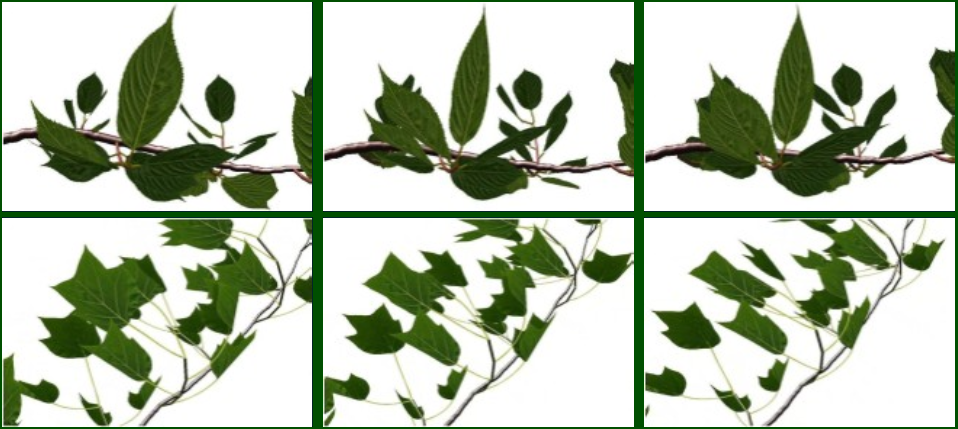
Abstract
We present a pseudo-dynamics model of a cantilever beam to visually simulate motions of leaves and branches in a wind field by considering the influence of natural frequency (f0) and damping ratio (e). Our pseudo-dynamics model consists of a static equilibrium model, which can handle the bending of a curved beam loaded by an arbitrary force in three-dimensions, and a dynamic motion model that describes the dynamic response of the beam subjected to turbulence. Using the static equilibrium model, we can apply it to controlling the free bending of petioles and branches. Furthermore, we extend it to a surface deformation model that can deform some flexible laminae. Based on a mass spring system, we analyze the property of dynamic response of a cantilever beam in turbulence with various combinations of f0 and e, and we give some guidelines to determine the combination types of branches and leaves according to their shapes and stiffness. The main advantage of our techniques is that we are able to deform curved branches and some flexible leaves dynamically by taking account of their structures. Finally, we demonstrate that our proposed method is effective by showing various motions of leaves and branches with different model
Shaojun Hu, Tadahiro Fujimoto, Pseudo-dynamics model of a cantilever beam for animating flexible leaves and branches in wind field. Computer Animation and Virtual Worlds, 2009. doi: 10.1002/cav.309. (Accepted by CASA2009) [Link][Preprint][Video1][Video2][Video3][Binary][Slides]
Acknowledgments
The authors would like to thank anonymous reviewers for their helpful suggestions. This work was supported by the Ministry of Education, Science, Sports and Culture, Japan with Grant No. 19300022.
BibTeX
@article {Hu_FC2009,
author = {Hu, Shaojun and Fujimoto, Tadahiro and Chiba, Norishige},
title = {Pseudo-dynamics model of a cantilever beam for animating flexible leaves and branches in wind field},
journal = {Computer Animation and Virtual Worlds},
year = {2009},
volume = {20},
number = {2-3},
pages = {279--287},
doi = {10.1002/cav.309}
}
